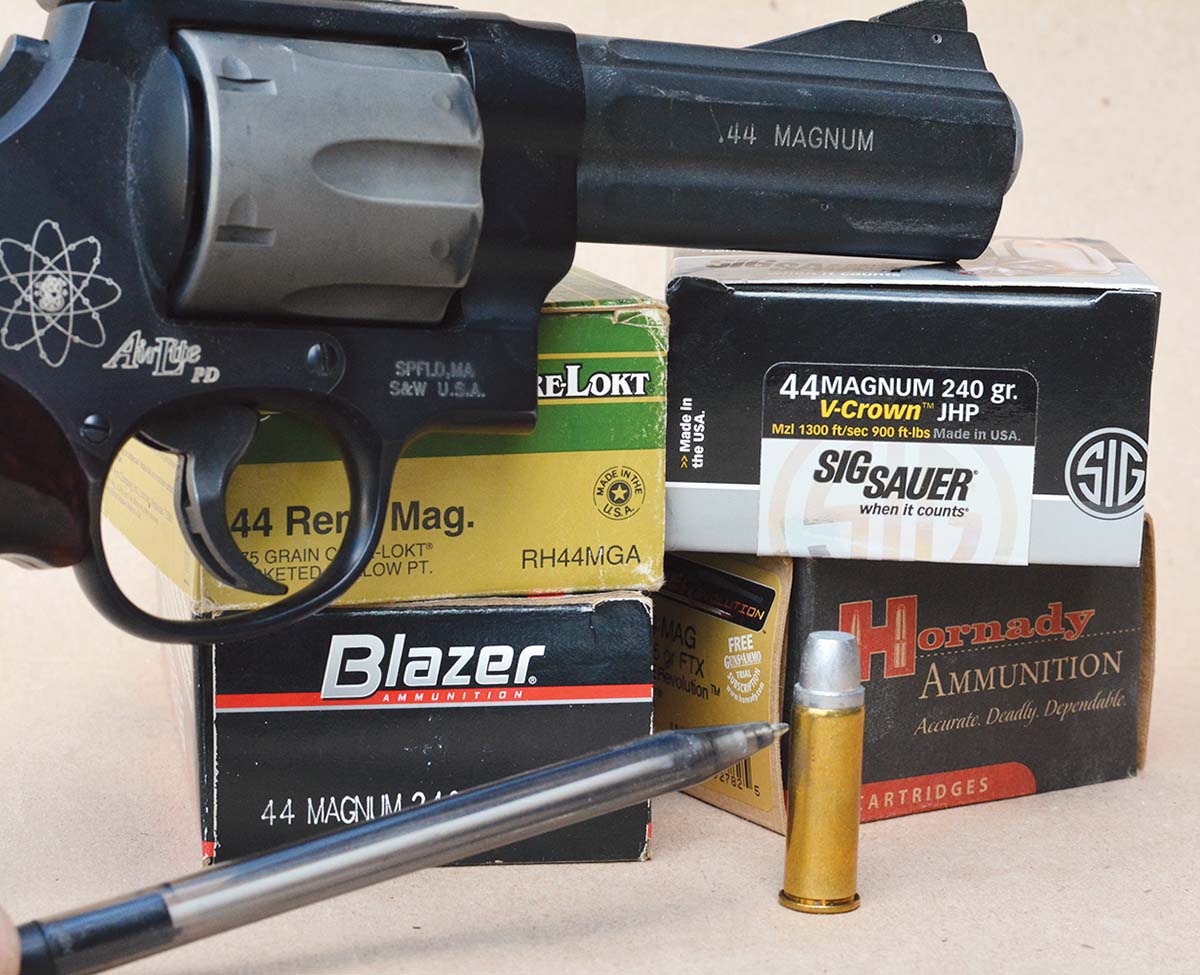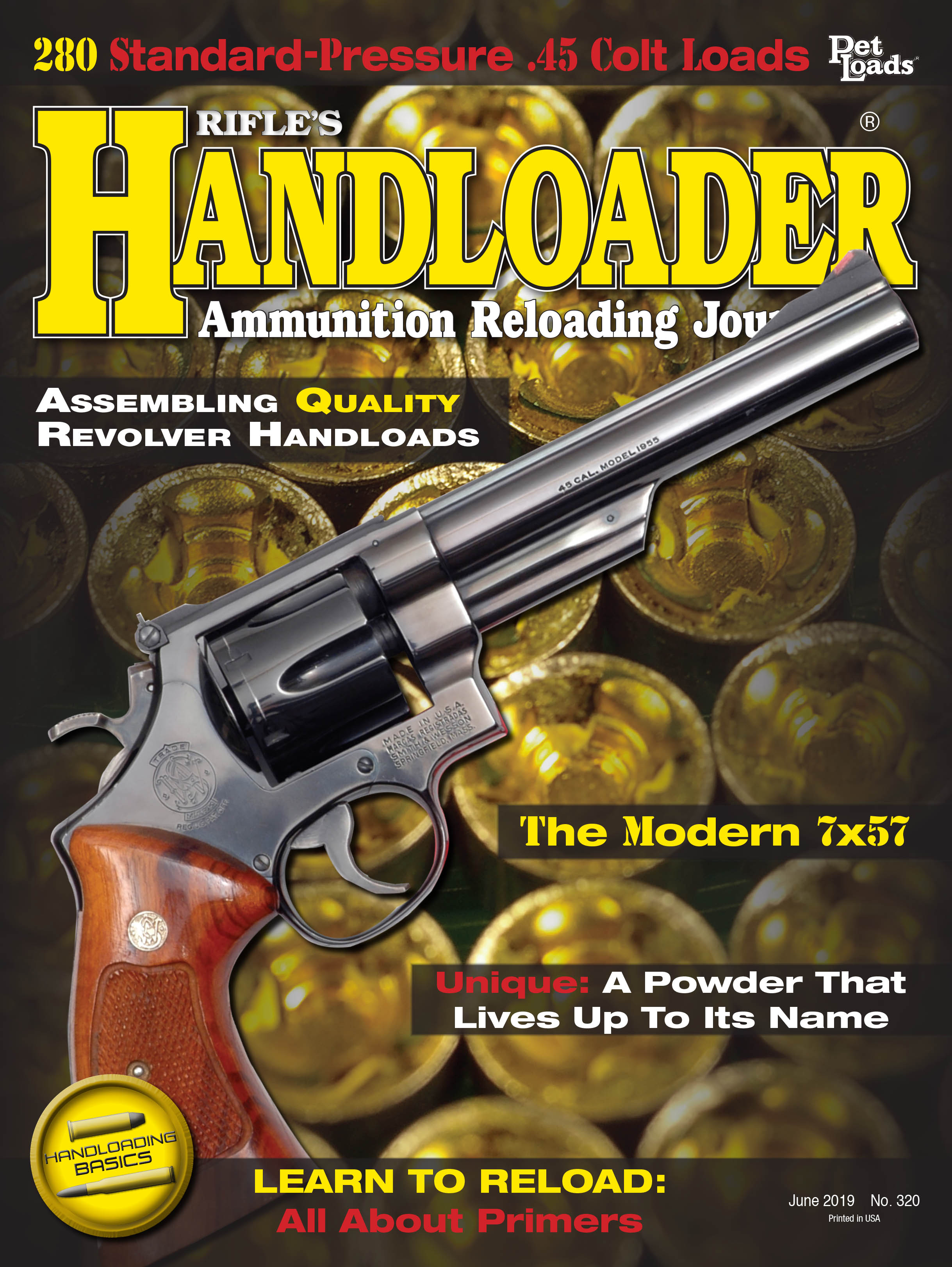Bullets & Brass
44 Magnum Jumping Crimp / New Powder for the 270 Winchester / 300 Blackout Bolt Action Subsonic Loads
column By: Brian Pearce |

44 Magnum Jumping Crimp
Q: A few years ago, I purchased a Smith & Wesson Model 329PD chambered in 44 Magnum. Due to its super-light 26 ounces, I like carrying it while fishing in Eastern Idaho trout streams where grizzly bears are prevalent. The drawback is that it really kicks hard, and I don’t shoot it much. However, the problem I’m having is keeping bullets from jumping out of the crimp. This has been a problem with both factory loads and my handloads. Apparently, I’m not the only one with this issue because the owner’s manual explains that I should load the gun with six cartridges of the type of ammunition that I want to use, but only fire five cartridges. Then inspect the sixth cartridge to see if the bullet is growing in length or jumping crimp. The manual states that if a problem exists with a particular brand of ammunition, I should not use it. I did just that and found that most factory loads allow bullets to jump crimp to one degree or another. I tested my handloads, and they did the same thing! The last thing I need is to have that gun freeze up when shooting in a self-defense situation.
I am using the 265-grain Keith bullet from a commercial caster, which is from RCBS 44-250-K, and it is pushed with 22.0 grains of Alliant 2400 powder. Do I need to change my bullet choice? Any advice would be appreciated.
Charles P., Driggs, ID
A: The Smith & Wesson ultra-light scandium 329PD offers quick recoil that is essentially pulling the bullets, and as you point out, is a problem with factory loads and handloads. Your bullet choice is fine, as that RCBS design (not a true Keith design) features a deep crimp groove allowing a heavy crimp. You don’t mention anything about your crimp, but a heavy roll crimp should be applied. More specifically, the case mouth should be in the very bottom of the crimp groove, but we are getting ahead of ourselves. I would suggest using new Starline or Hornady cases, as those two brands tend to be stiffer and will better hold the bullet when crimped. Cases that have been fired previously should be relegated to guns that offer a more normal level of recoil, or used for practice loads only. Naturally, new cases should be full-length sized prior to loading. The expander ball should be at least .004 inch to .005 inch smaller than the bullet diameter for even greater bullet pull. Last, your powder charge should be reduced with the 265-grain bullet, as it exceeds the SAAMI (Sporting Arms and Ammunition Manufacturers’ Institute) maximum pressure guidelines for the 44 Magnum at 36,000 pounds per square inch (psi). I would suggest dropping your charge to 19.0 grains, not exceeding 20.0 grains, which is within industry pressure guidelines. Frankly, there will be zero difference in terminal performance on a bear at close range! Good luck on your fishing trips.

New Powder for the 270 Winchester
Q: Being an old timer, I very much enjoyed your article, “The 270 Winchester Turns 100,” in Rifle magazine (No. 341, July 2025). Until reading your article, I had never heard of the Model 51 Winchester, and at first, I thought the Model number was a misprint. That was great information that I had never heard before, and I have been reading gun magazines and books for over 50 years.
The 270 was a dream cartridge when I was a kid, and I finally bought one after a tour in the Vietnam War. Over the years, I have added more 270s to my battery, including a 270 Weatherby and a 270 WSM, but I still prefer the original for deer hunting. Your article was nostalgic, and I decided to update my old handloads with better bullets and powders. I purchased some Nosler 140-grain Ballistic Tip and Accubond bullets as they might be the best compromise in terms of velocity and trajectory. With so many new powders available (many of which I have never used), I thought it would be helpful to contact you for advice. I have traditionally used Hodgdon H-4831 with various 130-grain bullets, but I always weighed each charge because my powder measure throws up to a 4.0-grain variance. This powder always gave good accuracy, but I’m hoping to begin throwing powder charges instead of weighing each one. Do you have a powder suggestion? I still want top velocities, but I do not want to give up accuracy. Data would also be appreciated.
Charles F., via Facebook
A: I think that Winchester StaBALL 6.5 powder will fit your criteria. It will give top velocities with 140-grain bullets, meters accurately, is temperature insensitive, clean burning and offers low extreme spreads. With that said, you might want to consider upgrading your powder measure, as modern measures from Redding, Hornady and others are distinct improvements over many older designs.
I would suggest starting with 51.0 grains and working up to a maximum charge of 55.0 grains, which will give an honest 3,000-plus feet per second (fps) from a 22-inch barrel.
Thanks for taking the time to read our magazines, and I’m glad that you enjoyed “The 270 Winchester Turns 100” article.

300 Blackout Bolt Action Subsonic Loads
Q: I have a Remington Model 7 chambered in 300 AAC Blackout, with a bolt-action rifle. I am not concerned about making it cycle the action like an AR-pattern rifle. Initially, I will only load 200-grain bullets, but I might try heavier bullets at a later time. For right now, I am looking for good load data that is subsonic. I consulted the Hodgdon 2025 Annual Manual Reloading, but the heaviest bullet weight data they offer is for 180-grain bullets. All of their data is way above subsonic, so I do not even have a reference point to begin. I know that it can be a bit tricky to load heavy-for-caliber bullets with long bearing surfaces at subsonic speeds. I thought you might be able to help. I have a local dealer that has an ample supply of most powders from Hodgdon, Accurate, Winchester and IMR. I should be able to come up with whatever powder that you suggest. I also have a few pounds of Alliant Reloder 10X on hand (if it is suitable). Thanks in advance.
Joel S., Phoenix AZ
A: Since you have Alliant Reloder 10X powder on hand, which is a great powder in this application, I would suggest starting with 13.0 grains for around 990 fps, while 13.8 grains (compressed) will give just under 1,100 fps (from 16-inch barrels). Another great powder choice includes Accurate 1680. Start with 12.0 grains and work up to 13.2 grains for just under 1,100 fps. I hope this helps.
Editor’s note: LoadData.com has many loads on the 300 Blackout, including heavy bullets in a bolt-action rifle. You can also check out the “Reloader’s Press” column in Handloadermagazine (No. 339, August 2022) for information on the 300 Blackout in a bolt-action rifle with a 16-inch barrel.


